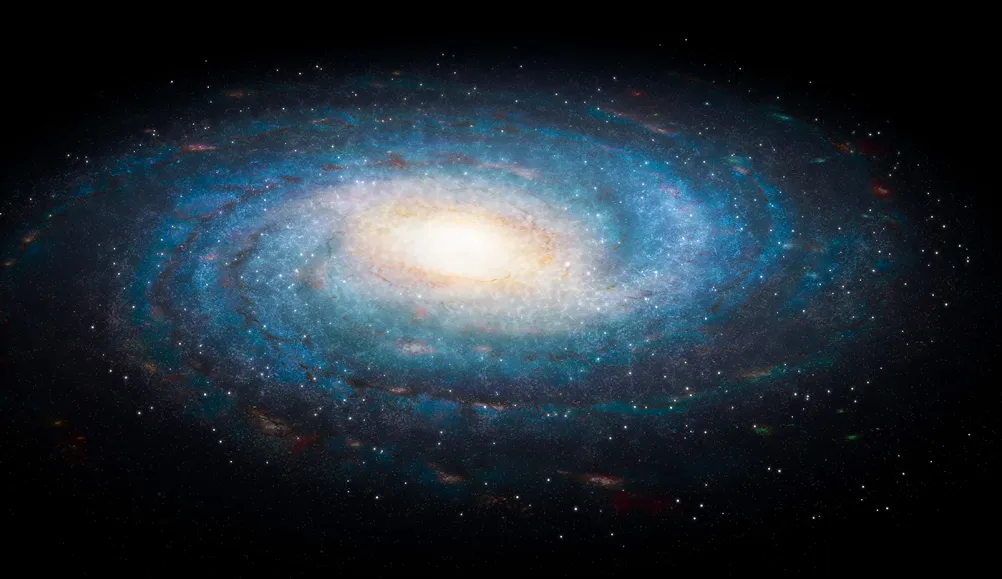Passing through the Milky Way’s arms may have helped form Earth’s solid ground
Our planet’s journey through the galaxy syncs up with the rhythm of long-ago crust formation

Every 200 million years, the solar system passes through a spiral arm of the Milky Way (illustrated). Those encounters may have played a role in forming Earth’s first continental crust.
MARK GARLICK/SCIENCE PHOTO LIBRARY/Getty Images
- More than 2 years ago
Earth’s journey through the Milky Way might have helped create the planet’s first continents.
Comets may have bombarded Earth every time the early solar system traveled through our galaxy’s spiral arms, a new study suggests. Those recurring barrages in turn helped trigger the formation of our planet’s continental crust, researchers propose August 23 in Geology.
Previous theories have suggested that such impacts might have played a role in forming Earth’s landmasses. But there has been little research explaining how those impacts occurred, until now, the team says.
It’s an intriguing hypothesis, other scientists say, but it’s not the last word when it comes to explaining how Earth got its landmasses.
To peer back in time, geochronologist Chris Kirkland and his colleagues turned to geologic structures known as cratons (SN: 12/3/10). These relics of Earth’s ancient continental crust are some of the planet’s oldest rocks. Using material from cratons in Australia and Greenland that are billions of years old, the team measured the chemistry of more than 2,000 bits of rock. The analysis let the researchers determine the exact ages of the rocks, and whether they had formed anew from molten material deep within the Earth or from earlier generations of existing crust.
When Kirkland and his colleagues looked for patterns in their measurements, the team found that new crust seemed to form in spurts at roughly regular intervals. “Every 200 million years, we see a pattern of more crust production,” says Kirkland, of Curtin University in Perth, Australia.
That timing rang a bell: It’s also the frequency at which the Earth passes through the spiral arms of the Milky Way (SN: 12/30/15). The solar system loops around the center of the galaxy a bit faster than the spiral arms move, periodically passing through and overtaking them. Perhaps cosmic encounters with more stars, gas and dust within the spiral arms affected the young planet, the team suggests.
The idea makes sense, the researchers say, since the higher density of material in the spiral arms would have led to more gravitational tugs on the reservoir of comets at our solar system’s periphery (SN: 8/18/22). Some of those encounters would have sent comets zooming into the inner solar system, and a fraction of those icy denizens would have collided with Earth, Kirkland and his team propose.
Earth was probably covered mostly by oceans billions of years ago, and the energy delivered by all those comets would have fractured the planet’s existing oceanic crust — the relatively dense rock present since even earlier in Earth’s history — and excavated copious amounts of material while launching shock waves into the planet. That mayhem would have primed the way for parts of Earth’s mantle to melt, Kirkland says. The resulting magma would have naturally separated into a denser part — the precursor to more oceanic crust — and a lighter, more buoyant liquid that eventually turned into continental crust, the researchers suggest.
That’s one hypothesis, but it’s far from a slam dunk, says Jesse Reimink, a geoscientist at Penn State who was not involved in the research. For starters, comet and meteorite impacts are notoriously tough to trace, especially that far back in time, he says. “There’s very few diagnostics of impacts.” And it’s not well-known whether such impacts, if they occurred in the first place, would have resulted in the release of magma, he says.
In the future, Kirkland and his colleagues hope to analyze moon rocks to look for the same pattern of crust formation (SN: 7/15/19). Our nearest celestial neighbor would have been walloped by about the same amount of stuff that hit Earth, Kirkland says. “You’d predict it’d also be subject to these periodic impact events.”







